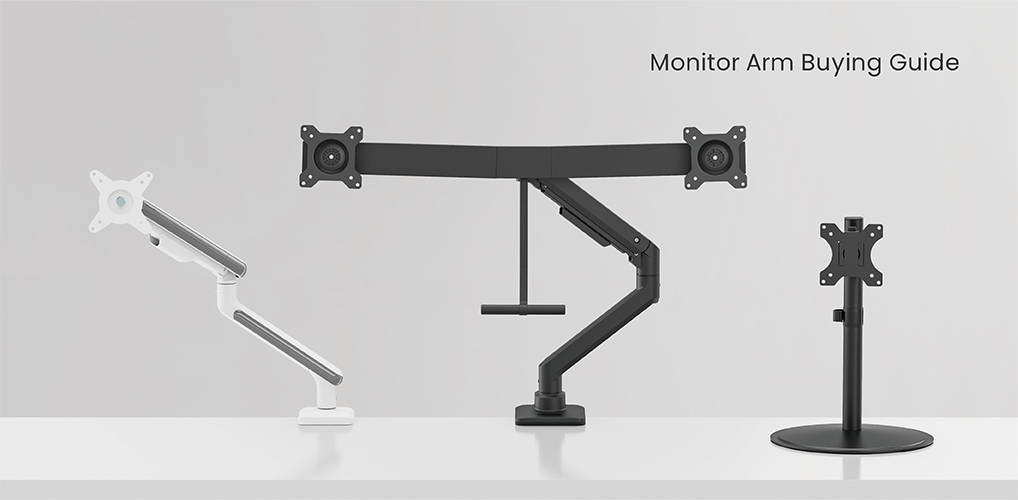The Ultimate Buying Guide: Choosing the Right Monitor Arm for Your Setup
Monitor arms, also called monitor mounts or brackets, are one of the most important setups for ergonomic office solutions, playing a key role in improving user health and efficiency. However, there are a variety of monitor arms on the market, and choosing a suitable monitor mount can be difficult. In this blog, we will explain seven factors to consider when choosing the right monitor mount, including the fit screen size, weight capacity, type, mounting options, and more, assisting you in finding the ideal monitor stand tailored to your needs and creating a comfortable and efficient workspace!
1. Ensure Your Monitor is VESA-Compliant
VESA is a technical standard that ensures the monitor and monitor arm are compatible by specifying the distance between the mounting holes on the back of the monitor. Below is a table of five common VESA standards, along with their hole patterns and supported monitor weights.
|
VESA Standard
|
Hole Pattern | Monitor Weight |
| FDMI MIS-B | 50 x 20 mm | ≤ 4.4 lbs / ≤ 2 kg |
| FDMI MIS-C | 75 x 35 mm | ≤ 10 lbs / ≤ 4.5 kg |
| FDMI MIS-D | 75 x 75 or 100 x 100 mm | ≤ 30.8 lbs / ≤ 14 kg |
| FDMI MIS-E | 200 x 100 mm | ≤ 50 lbs / ≤ 23.7 kg |
| FDMI MIS-F | 200 mm increments | ≤ 250 lbs / ≤ 113.6 kg |
Among these, MIS-D (75×75 mm or 100×100 mm) is the most prevalent. Our monitor mounts use VESA plates compatible with typical hole patterns, ensuring compatibility with most displays. If your monitor is not VESA compatible, you can purchase a separate adaptor plate or choose a non-VESA stand that is appropriate for your monitor.
Note: Most Apple displays do not follow VESA standards. To mount a non-VESA Apple display on a VESA-compatible arm, you will likely need a third-party adapter. iMac models can only be VESA-compatible if selected at purchase; this cannot be added later.
2. Consider the Fit Screen Size
Most monitor arms are designed to fit specific monitor sizes. Using a monitor arm that is too small or too large can lead to a poor user experience. Additionally, some monitor arms may not be flexible enough for extra-large monitors, especially if space below is limited. If you're using multiple monitors, oversized displays may bump into each other or not fit properly. Therefore, it's crucial to select a monitor arm that is precisely appropriate for your display size to create an ergonomic and productive workstation.
3. Consider Weight Capacity
Before making a purchase, be sure the monitor arm you choose can securely and confidently support your monitors. For example, if your monitor weighs 10kg and the monitor arm's weight capability is less than 10kg, then it would be wise to choose a monitor arm with a greater weight capacity. For heavier monitors, the most stable and safe solution is to use a heavy-duty monitor arm.
4. Verify the Screen Quantity
Consider your workspace and number of monitors when choosing a monitor arm. For limited space and a single monitor, an adjustable single monitor arm allows you to adjust your monitor flexibly while staying comfortable. For higher productivity with multiple displays, dual or multi-monitor arms help you multitask efficiently..
5. Choose Monitor Arm Types
There are three primary types of monitor arms available, each with its unique set of features. Compare and contrast them to find the right monitor arm for your display.
· Gas Spring Monitor Arm
The gas spring monitor arms are intended to counterbalance the weight of the monitor, allowing users to change the screen with little effort. The gas spring system enables smooth movement and accurate placement, resulting in optimal viewing angles. Gas spring monitor arms are ideal for customers seeking flexibility, simplicity of adjustment, and improved neck and eye health. Because of its unparalleled high performance, gas spring monitor arms are relatively expensive.
· Mechanical Spring Monitor Arm
Mechanical spring monitor arms, also known as spring-assisted monitor arms, use a series of mechanical springs to support monitors. These arms have adjustable tension settings that allow users to control the level of resistance when adjusting the monitor. Unlike gas spring arms that use pressurized gas, mechanical spring monitor arms use mechanical components to enable smooth and controlled adjustments. They provide stable support, ensuring that the monitor stays in place at the correct position. These arms are long-lasting, accurate, and efficient while being cost-effective, making them an excellent way to enhance workspace ergonomics and optimize monitor posture.
Articulating monitor arms are designed with a multi-joint structure that allows for a wide range of articulation and flexibility. With many pivot points, users can easily tilt, swivel, and rotate their monitors. These arms are highly adaptable and can be configured to suit different workplace setups and user preferences. Whether you need to adjust your monitor's viewing angle, switch between landscape and portrait orientations, or save desk space by retracting the monitor when not in use, articulating monitor arms offer the flexibility and versatility that you require.
6. Determine the Mounting Options
There are various options for mounting your monitor arm, such as clamp-mounted, grommet-mounted, wall-mounted, and freestanding. These mounting solutions serve different purposes and have varying levels of ease when it comes to installation. Therefore, you can select the best option to mount your monitor arm to your desktop based on your workspace configuration and personal preferences.
Clamp mounting is an incredibly stable and convenient option for most desks. Grommet base monitor arms are mostly suitable for desks with pre-drilled holes. For those with limited desktop space or no fixed desk, a wall-mounted monitor arm is an excellent choice, which can also provide more space. Freestanding monitor arms are best suited for desks with glass surfaces and are extremely easy to install.
7. Seek For Additional Features
When choosing a monitor arm, consider its features. For instance, some monitor arms come with cable management features that help keep everything organized. Others have a quick-release VESA plate that makes installation a breeze. Some even come with extra features like USB ports, multi-media connectors, or RGB lights. It's important to choose a monitor mount that has the features that meet your specific needs.
Conclusion
When deciding on your preferred monitor arm setup, take the time to explore the various factors available. Identify the monitor arm that best meets your needs for convenience and portability, resulting in an optimal increase in workplace efficiency. Our earnest goal is that you will find the appropriate monitor arm to fit your needs!







